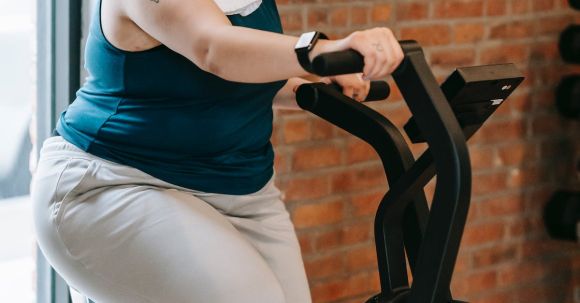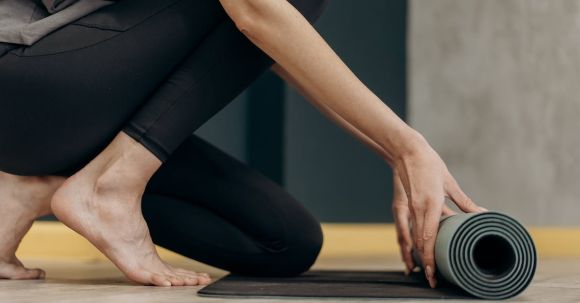Clearing the clutter in our minds is essential for maintaining mental and emotional well-being. In the fast-paced world we live in, it's easy to get caught up in the chaos and lose sight of our inner peace. That's why Fit is inviting you to join their 21-day meditation challenge to find clarity and tranquility in your daily life. Discover the transformative power of meditation and embark on a journey towards a clear mind.
Blog Posts
Are you tired of trying countless weight loss programs that don't seem to work for you? Do you struggle to find a program that fits your lifestyle? The good news is that there is a weight loss program out there for everyone. By understanding your own needs and preferences, you can find the right program that will lead you to success. In this article, we will explore different factors to consider when choosing a weight loss program and provide some tips on finding the one that suits you best.
Assess Your Goals and Preferences
Before diving into any weight loss program, it's important to assess your goals and preferences. Ask yourself, what are you trying to achieve? Are you looking to lose a significant amount of weight, or are you aiming for a more moderate approach? Understanding your goals will help you narrow down your options. Moreover, consider your lifestyle and personal preferences. Do you enjoy cooking and preparing meals, or would you prefer a program that provides pre-packaged meals? Do you prefer a structured program with set guidelines, or would you rather have more flexibility? By taking these factors into account, you can find a program that aligns with your needs.Consider Your Budget
Weight loss programs can vary significantly in cost. Before committing to a program, it's essential to consider your budget. Some programs require monthly fees, while others may involve purchasing specific foods or supplements. Take the time to research and compare different programs to find one that fits within your financial means. Remember, the most expensive program isn't always the most effective, so don't be swayed by price alone.Evaluate the Program's Approach
Weight loss programs adopt different approaches, and it's crucial to evaluate them before making a decision. Some programs focus on calorie counting and portion control, while others emphasize exercise and physical activity. There are also programs that promote specific diet plans, such as low-carb or low-fat diets. Consider which approach resonates with you the most and aligns with your goals. Remember, sustainable weight loss is about making long-term lifestyle changes, so choose a program that promotes healthy habits that you can maintain in the long run.Research Success Stories and Reviews
One of the best ways to gauge the effectiveness of a weight loss program is by researching success stories and reading reviews. Look for testimonials from people who have achieved their weight loss goals through the program you are considering. Pay attention to their experiences and whether they faced any challenges along the way. Additionally, read reviews from reputable sources to get an unbiased perspective. Keep in mind that everyone's journey is different, so look for patterns and overall satisfaction when evaluating the program's success rate.Seek Professional Guidance
If you're unsure about which weight loss program is right for you, consider seeking professional guidance. A registered dietitian or nutritionist can assess your individual needs and provide personalized recommendations. They can help you create a balanced meal plan, set realistic goals, and provide ongoing support throughout your weight loss journey. Having a professional by your side can increase your chances of success and ensure that you're making healthy choices.Conclusion: Your Path to Weight Loss Success
Finding the right weight loss program for your lifestyle is essential for achieving long-term success. By assessing your goals and preferences, considering your budget, evaluating the program's approach, researching success stories and reviews, and seeking professional guidance, you can make an informed decision. Remember, weight loss is a journey, and finding a program that fits your lifestyle will set you on the path to success.
Sugar, a common ingredient found in many of our favorite foods and beverages, has become a significant concern in terms of its impact on our health. While it may add a delightful sweetness to our taste buds, the excessive consumption of sugar has been linked to various health issues, ranging from obesity to heart disease. In this article, we will explore the detrimental effects of sugar on our overall health and well-being.
The Sugar Trap
One of the main reasons why sugar is so addictive is its ability to trigger the brain's reward center. When we consume sugar, our brains release dopamine, a neurotransmitter associated with pleasure and reward. This dopamine release creates a feeling of euphoria and prompts us to seek out more sugar. Unfortunately, this cycle can lead to a sugar addiction, making it difficult to resist sugary treats.Weight Gain and Obesity
Excessive sugar consumption is strongly associated with weight gain and obesity. When we consume sugary foods and beverages, our bodies convert the sugar into glucose, which then enters our bloodstream. Insulin, a hormone produced by the pancreas, is responsible for regulating our blood sugar levels. However, when we consume too much sugar, our bodies struggle to produce enough insulin to keep up, leading to elevated blood sugar levels. This excess sugar is then converted into fat, resulting in weight gain.Increased Risk of Chronic Diseases
Consuming excessive amounts of sugar has been linked to an increased risk of chronic diseases such as type 2 diabetes, heart disease, and certain types of cancer. High sugar intake can lead to insulin resistance, a condition in which cells become less responsive to the effects of insulin. This can eventually lead to the development of type 2 diabetes. Additionally, a diet high in sugar has been shown to increase the risk of heart disease by raising blood pressure, promoting inflammation, and contributing to unhealthy cholesterol levels.Negative Impact on Dental Health
Sugar is a primary contributor to tooth decay and cavities. When we consume sugary foods and beverages, the bacteria in our mouths feed on the sugar and produce acids. These acids erode the enamel on our teeth, leading to cavities and tooth decay. Over time, this can result in the need for extensive dental work and can negatively impact our overall oral health.Reduced Energy Levels
While sugar may provide a temporary energy boost, it ultimately leads to a crash in energy levels. Consuming high amounts of sugar causes a rapid spike in blood sugar levels, followed by a sharp drop. This rollercoaster effect can leave us feeling tired, sluggish, and lacking in energy. Additionally, excessive sugar consumption has been linked to poor sleep quality, further exacerbating feelings of fatigue.The Key to a Healthy Lifestyle
Reducing our sugar intake is crucial for maintaining good health. By making conscious choices to limit our consumption of sugary foods and beverages, we can significantly reduce the negative impact sugar has on our bodies. Opting for whole, unprocessed foods and choosing natural sweeteners such as fruit can help satisfy our sweet cravings in a healthier way. In conclusion, the impact of sugar on our health is undeniable. From weight gain and obesity to an increased risk of chronic diseases, excessive sugar consumption can have severe consequences. By being mindful of our sugar intake and making healthier choices, we can take control of our well-being and pave the way for a healthier lifestyle.
Losing weight and maintaining a healthy lifestyle can often feel like an uphill battle. Fad diets come and go, leaving people feeling frustrated and defeated. But what if there was a program that could provide a lasting solution? Fit on Programs may just hold the key to unlocking the code to lasting weight loss.
The Problem with Fad Diets
Fad diets promise quick results with minimal effort, but they often fail to deliver on their promises. These diets typically restrict certain food groups or severely limit calorie intake, leading to short-term weight loss that is difficult to sustain. Additionally, many fad diets promote unhealthy eating habits and can have negative effects on overall health.The Fit on Approach
Fit on Programs take a different approach to weight loss. Instead of focusing on quick fixes, these programs prioritize long-term success through a combination of nutrition, exercise, and mindset. By addressing the root causes of weight gain and incorporating sustainable lifestyle changes, Fit on Programs offer a comprehensive solution for lasting weight loss.Nutrition: Fueling the Body
One of the key components of Fit on Programs is nutrition. Rather than restrictive diets, these programs emphasize a balanced approach to eating. By focusing on whole foods, portion control, and mindful eating, participants learn how to nourish their bodies and make healthier choices. The goal is not to eliminate certain foods, but rather to develop a sustainable and enjoyable way of eating that supports long-term weight loss.Exercise: Moving with Purpose
Another integral part of Fit on Programs is exercise. These programs offer a variety of workout options, ranging from high-intensity interval training to yoga and everything in between. The emphasis is on finding activities that are enjoyable and sustainable, so participants can incorporate regular exercise into their daily lives. By making fitness a priority, individuals can boost their metabolism, build lean muscle, and increase overall energy levels.Mindset: Changing the Narrative
One often overlooked aspect of weight loss is mindset. Fit on Programs recognize that successful weight loss is not just about physical changes but also about shifting the way we think about ourselves and our bodies. These programs provide tools and resources to help individuals develop a positive mindset, overcome self-limiting beliefs, and cultivate self-compassion. By addressing the emotional and psychological aspects of weight loss, participants can create lasting change from within.The Benefits of Fit on Programs
The holistic approach of Fit on Programs offers numerous benefits beyond just weight loss. Participants often experience increased energy levels, improved mood, better sleep, and enhanced overall well-being. By focusing on sustainable lifestyle changes, these programs equip individuals with the tools they need to maintain their weight loss and continue living a healthier life long after the program ends.Unlocking the Code to Lasting Weight Loss
Fit on Programs provide a comprehensive approach to weight loss that goes beyond quick fixes and fad diets. By addressing nutrition, exercise, and mindset, these programs offer a sustainable solution for lasting weight loss. Whether you're looking to shed a few pounds or completely transform your lifestyle, Fit on Programs can help you unlock the code to lasting weight loss and achieve the healthy, happy life you deserve. In conclusion, Unlocking the code to lasting weight loss requires a holistic approach that addresses nutrition, exercise, and mindset. Fit on Programs offer a sustainable solution that goes beyond fad diets and quick fixes. By focusing on whole foods, regular exercise, and developing a positive mindset, individuals can achieve lasting weight loss and enjoy the many benefits of a healthy lifestyle. Say goodbye to the frustration of yo-yo dieting and unlock the code to lasting weight loss with Fit on Programs.
In today's fast-paced world, finding ways to relax and take care of our mental and physical well-being is more important than ever. One popular way to achieve this balance is through the practice of yoga and meditation. These ancient practices have been used for centuries to promote health, reduce stress, and increase self-awareness. In this article, we will explore the numerous benefits that yoga and meditation can bring to your mind and body.
Stress Reduction and Relaxation
One of the primary benefits of yoga and meditation is their ability to reduce stress and promote relaxation. The deep breathing exercises and gentle stretching in yoga help to calm the nervous system and release tension in the body. Meditation, on the other hand, allows the mind to quiet down and focus on the present moment, relieving anxiety and promoting a sense of peace. Regular practice of these techniques can significantly reduce stress levels and improve overall well-being.Improved Mental Clarity and Focus
In addition to reducing stress, yoga and meditation can also enhance mental clarity and focus. The practice of yoga involves holding poses and focusing on the breath, which helps to improve concentration and increase mindfulness. Meditation, on the other hand, trains the mind to stay present and focused, reducing mental chatter and enhancing cognitive abilities. By incorporating these practices into your routine, you can experience improved mental clarity and better decision-making skills.Increased Flexibility and Strength
Yoga is well-known for its ability to increase flexibility and strength. Through a series of poses, yoga stretches and strengthens the muscles, improving overall flexibility and mobility. The regular practice of yoga can also help to tone and sculpt the body, leading to increased strength and endurance. Whether you are a beginner or an advanced practitioner, yoga offers a variety of poses and modifications that can be tailored to your individual needs and abilities.Enhanced Emotional Well-being
Yoga and meditation have been shown to have a positive impact on emotional well-being. The combination of physical movement, breath control, and mindfulness helps to release emotional blockages and promote a sense of inner peace. Regular practice of these techniques can improve mood, reduce symptoms of depression and anxiety, and increase overall happiness. By incorporating yoga and meditation into your daily routine, you can experience a greater sense of emotional balance and well-being.Improved Sleep Quality
For those struggling with sleep issues, yoga and meditation can be a game-changer. The relaxation techniques and deep breathing exercises in these practices help to calm the mind and prepare the body for sleep. Regular practice can improve sleep quality, reduce insomnia, and promote a more restful night's sleep. By incorporating a short yoga or meditation session before bed, you can create a relaxing bedtime routine that will help you unwind and prepare for a good night's rest. In conclusion, the benefits of yoga and meditation for the mind and body are numerous and well-documented. These practices offer a holistic approach to health and well-being, helping to reduce stress, improve mental clarity, increase flexibility and strength, enhance emotional well-being, and improve sleep quality. By incorporating yoga and meditation into your daily routine, you can experience these benefits and achieve a greater sense of balance and harmony in your life. So, why not give it a try and discover the transformative power of yoga and meditation for yourself?
Cardio workouts are a fantastic way to improve your cardiovascular health and burn calories. However, if not done correctly, they can also lead to injuries. To ensure that you get the most out of your cardio sessions without risking harm, it is important to take certain precautions. In this article, we will explore some tips on how to prevent injuries during cardio workouts.
Warm Up Properly
One of the most crucial steps in preventing injuries during cardio workouts is to warm up properly. Before jumping into a high-intensity exercise, it is essential to prepare your body by gradually increasing your heart rate and loosening up your muscles. A good warm-up can include dynamic stretches, light jogging, or even some jumping jacks. Taking just a few minutes to warm up can make a significant difference in preventing strains and other injuries.Use Proper Form
Another important aspect of injury prevention during cardio workouts is using proper form. Whether you are running, cycling, or doing high-impact exercises, maintaining the correct posture and technique is crucial. For example, when running, make sure to land on the balls of your feet instead of your heels to avoid unnecessary strain on your joints. Similarly, when cycling, adjust the seat height to ensure proper alignment of your knees and hips. Paying attention to your form can help you avoid injuries and maximize the effectiveness of your workouts.Gradually Increase Intensity
It can be tempting to push yourself too hard during cardio workouts, especially if you are determined to achieve quick results. However, this can be a recipe for disaster. To prevent injuries, it is important to gradually increase the intensity of your workouts over time. This allows your body to adapt and become stronger without putting excessive stress on your muscles and joints. Start with shorter sessions and lower intensities, then gradually build up as your fitness level improves.Listen to Your Body
One of the most important things you can do to prevent injuries during cardio workouts is to listen to your body. Pay attention to any signs of pain or discomfort, and take them seriously. Pushing through pain can lead to more severe injuries and longer recovery times. If something doesn't feel right, it is better to take a break or consult with a healthcare professional rather than risking further damage. Remember, your body knows best, so trust its signals.Allow for Adequate Recovery
While it is important to challenge yourself during cardio workouts, it is equally important to allow for adequate recovery. Overtraining can lead to fatigue, decreased performance, and an increased risk of injuries. Make sure to schedule rest days in your workout routine and incorporate activities that promote recovery, such as stretching and foam rolling. Giving your body time to rest and repair will help you prevent injuries and optimize your overall fitness progress. In conclusion, preventing injuries during cardio workouts is crucial for maintaining a safe and effective fitness routine. By warming up properly, using proper form, gradually increasing intensity, listening to your body, and allowing for adequate recovery, you can minimize the risk of injuries and enjoy the numerous benefits of cardio exercise. So lace up your shoes, grab your water bottle, and get ready to sweat safely!
Working out at home has become increasingly popular, especially in light of recent events that have limited our access to gyms and fitness centers. While it may seem convenient and easy to workout at home, staying motivated can be a challenge. Without the structure and energy of a gym environment, it's easy to get distracted or lose motivation. However, with a few simple tips, you can stay motivated and make the most out of your home workouts.
Create a Dedicated Workout Space
One of the most important factors in staying motivated when working out at home is to create a dedicated workout space. By designating a specific area in your home for exercise, you create a physical and mental separation between your workout time and the rest of your daily activities. This space can be a spare room, a corner in your living room, or even just a yoga mat on the floor. Whatever it may be, make sure it is free from distractions and has enough room for you to move comfortably.Set Clear and Achievable Goals
Having clear and achievable goals is crucial for maintaining motivation. Whether you want to lose weight, build muscle, or improve your overall fitness level, setting specific goals will give you something to work towards. Break down your goals into smaller, manageable milestones, and celebrate your progress along the way. This will help you stay focused and motivated, as you will have a sense of accomplishment every time you reach a milestone.Mix Up Your Routine
Doing the same workout routine day after day can quickly become monotonous and boring. To stay motivated, it's important to mix up your routine and keep things interesting. Try different types of workouts, such as HIIT, yoga, or dance cardio. You can also vary the intensity, duration, or equipment used in your workouts. By constantly challenging yourself and trying new things, you'll keep your workouts fresh and exciting.Find a Workout Buddy
Working out alone at home can be isolating and uninspiring. Finding a workout buddy, either in person or virtually, can greatly enhance your motivation. Having someone to exercise with can provide accountability and support. You can encourage each other, share workout ideas, and even compete in friendly challenges. Additionally, working out with a buddy can make your workouts more enjoyable and social, even if you're not physically together.Use Technology to Your Advantage
Technology can be a powerful tool for staying motivated when working out at home. There are countless fitness apps, online classes, and streaming platforms that offer a wide variety of workouts. Find one that suits your interests and needs, and use it as a source of inspiration and guidance. You can also track your progress, set reminders, and join virtual fitness communities to stay connected and motivated.Reward Yourself
Rewarding yourself for your hard work and dedication can be a great way to stay motivated. Set small rewards for yourself when you reach certain milestones or achieve your goals. It could be treating yourself to a massage, buying new workout gear, or indulging in a favorite healthy snack. By acknowledging your progress and treating yourself, you'll stay motivated and continue to push yourself towards your fitness goals. In conclusion, staying motivated when working out at home can be a challenge, but with the right strategies, it is entirely possible. By creating a dedicated workout space, setting clear goals, mixing up your routine, finding a workout buddy, utilizing technology, and rewarding yourself, you can stay motivated and make the most out of your home workouts. Remember, consistency is key, so keep pushing yourself and stay committed to your fitness journey.
Flexibility plays a crucial role in various activities, from sports and exercise to everyday tasks. Having good flexibility not only improves your performance but also reduces the risk of injuries. If you're looking to enhance your flexibility, here are some effective strategies to incorporate into your routine.
1. Stretch before and after exercise
Stretching is essential for improving flexibility. Before starting any physical activity, it's important to warm up your muscles with dynamic stretches. These stretches involve moving your body parts through a full range of motion. After your workout, perform static stretches to lengthen and relax your muscles. Hold each stretch for 15-30 seconds and repeat on both sides.2. Incorporate yoga into your routine
Yoga is a fantastic way to enhance your flexibility. The various poses in yoga focus on stretching and strengthening different muscle groups. Regular practice can improve your overall flexibility and range of motion. Consider joining a yoga class or following along with online tutorials to reap the benefits of this ancient practice.3. Use foam rollers or massage balls
Foam rollers and massage balls are excellent tools for targeting specific muscles and releasing tension. They work by applying pressure to different areas of your body, helping to improve flexibility and reduce muscle soreness. Incorporate foam rolling or self-massage into your routine, paying attention to areas that feel tight or restricted.4. Perform dynamic stretches daily
Dynamic stretches involve moving your body while stretching, and they are particularly effective in improving flexibility and mobility. Incorporate dynamic stretches into your daily routine, focusing on areas that need extra attention. Examples of dynamic stretches include leg swings, arm circles, and torso twists.5. Practice deep breathing techniques
Deep breathing techniques not only promote relaxation but also enhance flexibility. When you take slow, deep breaths, you allow your muscles to relax and stretch more effectively. Incorporate deep breathing exercises into your stretching routine to maximize the benefits.6. Gradually increase your range of motion
Improving flexibility takes time and patience. It's crucial to gradually increase your range of motion to avoid overstretching or injuring yourself. Start with gentle stretches and gradually push yourself a little further each time. Listen to your body and stop if you feel any pain or discomfort.7. Stay consistent with your stretching routine
Consistency is key when it comes to improving flexibility. Set aside dedicated time each day to focus on stretching and mobility exercises. By making it a habit, you'll see significant improvements in your flexibility over time.8. Seek professional guidance
If you're unsure about the best stretching techniques or have specific flexibility goals, consider seeking guidance from a professional, such as a personal trainer or physical therapist. They can assess your current flexibility levels and develop a personalized stretching routine to help you achieve your goals safely and effectively.9. Incorporate strength training into your routine
Strength training exercises, such as weightlifting or resistance training, can also improve flexibility. As you build strength in your muscles, it becomes easier to perform stretches and increase your range of motion. Include strength training exercises that target your major muscle groups to complement your flexibility routine.10. Listen to your body
Lastly, always listen to your body. If a stretch feels uncomfortable or painful, modify it or choose a different stretch altogether. Flexibility is a journey, and it's essential to prioritize safety and avoid pushing your body beyond its limits. In conclusion, improving flexibility is essential for better performance in various activities. By incorporating these strategies into your routine, you can enhance your flexibility, reduce the risk of injuries, and ultimately achieve your fitness goals. So, start stretching and enjoy the benefits of a more flexible body.
Maintaining a healthy diet can sometimes be challenging, especially when faced with tempting treats and busy schedules. However, with dedication and a few helpful strategies, you can stay on track with your diet goals and achieve the results you desire. In this article, we will explore effective ways to stay focused and motivated on your journey towards a healthier lifestyle.
Set Clear and Realistic Goals
The first step in staying on track with your diet goals is to set clear and realistic objectives. Rather than aiming for drastic changes overnight, start by setting small, attainable goals that you can gradually work towards. For example, instead of completely cutting out sweets, you can aim to reduce your sugar intake by a certain percentage each week. By setting achievable goals, you will feel a sense of accomplishment, which will motivate you to continue making progress.Plan Your Meals and Snacks
One of the most effective ways to stay on track with your diet goals is to plan your meals and snacks in advance. By taking the time to prepare and pack your meals, you are less likely to make impulsive and unhealthy choices when hunger strikes. Additionally, having healthy snacks readily available can prevent you from reaching for convenient, but calorie-laden alternatives. Consider creating a weekly meal plan and grocery list to ensure you have nutritious options on hand at all times.Practice Mindful Eating
Mindful eating is an essential practice when it comes to staying on track with your diet goals. Instead of mindlessly devouring your meals, take the time to savor and appreciate each bite. Pay attention to your body's hunger and fullness cues and stop eating when you feel satisfied, rather than when your plate is empty. By being present and mindful while eating, you can better tune into your body's needs and make healthier choices.Stay Hydrated
Staying hydrated is crucial for overall health and can also aid in weight management. Often, we mistake thirst for hunger and end up consuming unnecessary calories. By drinking an adequate amount of water throughout the day, you can curb cravings and prevent overeating. Aim to drink at least eight glasses of water daily, and consider carrying a reusable water bottle with you to stay hydrated on the go.Find Healthy Alternatives
Another way to stay on track with your diet goals is to find healthier alternatives for your favorite indulgences. Craving something sweet? Opt for a piece of fruit or a naturally sweetened snack. Want something crunchy? Choose baked kale chips or air-popped popcorn instead of greasy potato chips. By experimenting with nutritious alternatives, you can satisfy your cravings while still nourishing your body.Seek Support and Accountability
Staying motivated on your diet journey can be challenging, but seeking support and accountability can make a world of difference. Consider partnering with a friend or family member who shares similar goals, and hold each other accountable. You can also join online communities or support groups where you can connect with like-minded individuals who can offer encouragement and advice.Reward Yourself
Lastly, remember to reward yourself along the way. Celebrate your achievements, no matter how small, and treat yourself to something you enjoy. However, be mindful of your choices and opt for non-food rewards whenever possible. Consider treating yourself to a relaxing spa day, buying a new outfit, or indulging in a hobby you love. By rewarding yourself, you reinforce positive behavior and stay motivated to continue making progress. In conclusion, staying on track with your diet goals requires dedication and a few helpful strategies. By setting clear and realistic goals, planning your meals and snacks, practicing mindful eating, staying hydrated, finding healthy alternatives, seeking support, and rewarding yourself, you can maintain a healthy diet and achieve your desired results. Remember, consistency is key, and every small step towards a healthier lifestyle is a step in the right direction.
In the world of sports, athletes are constantly looking for ways to gain a competitive edge and improve their performance. One effective method that has gained popularity in recent years is sports-specific training. This type of training is designed to enhance the specific skills and abilities needed for a particular sport, taking athletes to the next level of performance. Whether you're a professional athlete or a weekend warrior, sports-specific training can help you reach your full potential.









